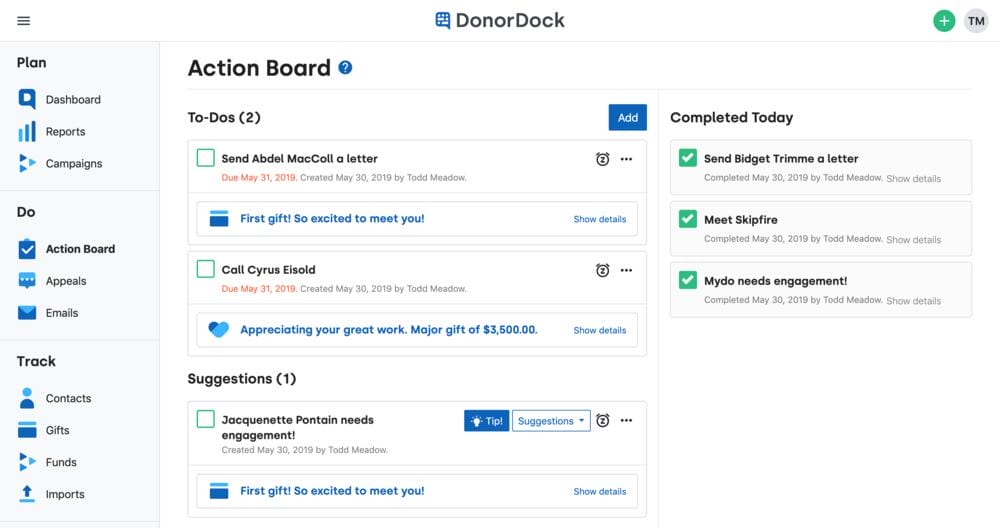John Machacek, Chief Innovation Officer for the Greater Fargo Moorhead Economic Development Corporation, has worked with countless startups throughout our community over the past seven years. He knows their ups, their downs, but most of all, he knows the questions to ask them.
Here is John Machacek’s 10 questions for DonorDock‘s Founder Matt Bitzegaio, who runs a CRM company specifically designed for nonprofit fundraising.
1. Tell us your DonorDock elevator pitch?
DonorDock is a relationship management platform that equips nonprofit organizations with the tools they need to cultivate deeper-impact donor relationships. Many nonprofits struggle to have a holistic strategy when it comes to donor relationships. DonorDock’s innovative nudge technology encourages meaningful, personalized donor engagement based on fundraising best practices. While many competing tools are over-complicated, difficult to adopt, and costly, DonorDock takes a reductionist approach in the solution. By providing software that is prescriptive, intuitive, and cost-effective, DonorDock relieves the challenges and burdens of traditional donor management and CRM software and enables nonprofits to align their time around their purpose.
2. Time and money resources are precious to non-profits and some may worry about the cost as well as the effort, because many may not even have any type of non-profit management software. How do you dispel those worries?
The truth is, many nonprofits have had negative experiences with donor software. That makes our job harder to convince them DonorDock is different. When we say it is intuitive, that is not simply lip service. When we say we provide the highest level of customer service we can, we mean it. When we say the implementation time and cost will be significantly lower than other solutions they have considered, that is based on consistent experience and feedback from other customers. Many of our customers can’t believe there isn’t a long implementation or training requirement, but once they get into the platform, they understand it just makes sense and really works. Our 30-day trial is one way we can show them firsthand, with zero risk.
3. Your product is a subscription-based service (SaaS) and I know those SaaS models can be difficult in generating revenue fast enough to recoup the front-end development costs. How has that process worked out for you?
This is a relatively common concern for SaaS startups, which is why many are forced to take on debt or give up equity early. We were fortunate in that we created and built the DonorDock product ourselves, allowing us to get to market without the requirement of a large capital investment to complete the software development. We have also been able to follow the pattern of other successful startups in our area and perform services work to self-fund the growth of DonorDock. Companies like Bushel and Co-Schedule have been great examples to follow from that perspective.

4. With the product now on the market for two years, during that time, did you use customer feedback as a way to refine DonorDock capabilities?
Yes, customer feedback is an incredibly important part of our process for identifying areas of the product to invest our resources in. There must be a balance, however, as all customer requests won’t make sense to add to the product. We typically analyze each request against a set of questions:
- Does this idea provide value to a large number of our customers?
- Does the idea align with our business goals and strategies?
- Is this technically feasible to do, and does it add unneeded complexity to the product?
If we are able to satisfactorily answer those questions, the idea is a good candidate for the product.
5. How do you effectively ask for this feedback?
Some feedback is organic, coming in from customers as they come across needs or questions. We typically encourage customer feedback in many avenues and opportunities, however. One way is through our monthly user group meetings. These have become a great way for us to spend time with customers and catalog their ideas, questions and concerns. We also leverage a tool called Feature Upvote that allows us to have an idea board. Customers are able to submit ideas and vote on ideas. This lets us compare ideas and requests in a more scientific, analytical way. This way, we answer the question of whether a suggestion, feature or improvement will positively impact a large portion of our customers. We also just started doing customer engagement calls on a regular interval with the hope of acquiring feedback from our less vocal customers.
6. Speaking of easy-to-use, you and I were talking earlier about mutual experiences in the past of using software platforms that were robust but they also required many hours and thousands of dollars for one-on-one training to understand how to use the platform. How and why you are taking a different approach with DonorDock user integration?
Unfortunately, it is pretty common for CRM software implementations to be lengthy and extremely costly. Most enterprise type CRM solutions are monolithic and complicated. They can usually solve many business problems, however, with that flexibility often comes complexity. While that approach may work for some nonprofits, many don’t have the resources or staff to undertake such an investment of time and money. In addition, that complexity often leads to a lack of true organizational adoption, so you end up with expensive solutions being used at a fraction of their capabilities, that don’t provide a great deal of value. With DonorDock, we built a CRM specifically designed for small to midsize nonprofits to reduce a lot of that burden – a tool that has the features they need, but in a package that is intuitive and fosters adoption. I will always remember, shortly after launching DonorDock we had a customer who moved from a product built on one of the larger CRM tools. After the first day, she commented through social media that she already felt more comfortable with DonorDock in one day than she was with their previous solution after over a year. I have always felt that was a great testament to our approach and the value DonorDock provides.
7. You’ve mentioned to me the personal satisfaction you and your team has had with helping non-profits better manage themselves. What is the most rewarding aspect?
Our team members all have a passion for unlocking greater impact for nonprofits through our products. That really begins with building a product that functions the way nonprofits function. Our work has a direct impact on our customer’s ability to further their missions. We especially love seeing small nonprofits realize DonorDock is a tool to help them find new efficiency and success. Many of our customers are single-person organizations run by someone who is passionate about their cause. The reality is many of those people have never fundraised before, but realize it is a necessity to keep their mission moving. For us to be able to see how DonorDock uses our nudge technology to help them know where to start and coach them through learning to fundraise is extremely rewarding.
8. Can you explain what you mean by “nudge technology”?
One of the things many nonprofit professionals struggle with is to know what to do and when to do it to improve their fundraising. In DonorDock we have a tool called the “Action Board” that is constantly analyzing data and nudging users to take certain actions based on fundraising best practices. I can’t count the number of times I have been told by our customers they read articles or attend training and hear great ideas – then they get back to their desk and can’t figure out where to start or how to actually implement the ideas. DonorDock’s nudge technology helps to fill those gaps and coaches them on how to implement fundraising strategies, by providing timely reminders and action items.
9. If you could go back in time to Matt from a few years ago, what hindsight advice would you give yourself?
Don’t focus too much on the product and not enough on the go-to-market strategy. I think it is far too common for entrepreneurs to want to build the best product possible, and they don’t launch early enough, and they don’t have a solid growth strategy defined up front. Essentially, “perfection-paralysis”. One thing I have learned over the last few years is it is not enough to build a great product. Having a strong plan for marketing and sales is a key piece to building a successful SaaS product.
10. What can we do as a community to help DonorDock succeed?
Like most SaaS startups, we need to continue to grow our customer base. Referrals and introductions are especially helpful when trying to have meaningful conversations with prospects. There are approximately 1,800 nonprofit organizations in Cass and Clay counties alone and we would love to continue to move as many of them to DonorDock as we can. This local and regional growth will help us continue to build a solid foundation as we strive to establish DonorDock as a national brand. So, introductions and referrals would be a tremendous help as we continue down this path.








